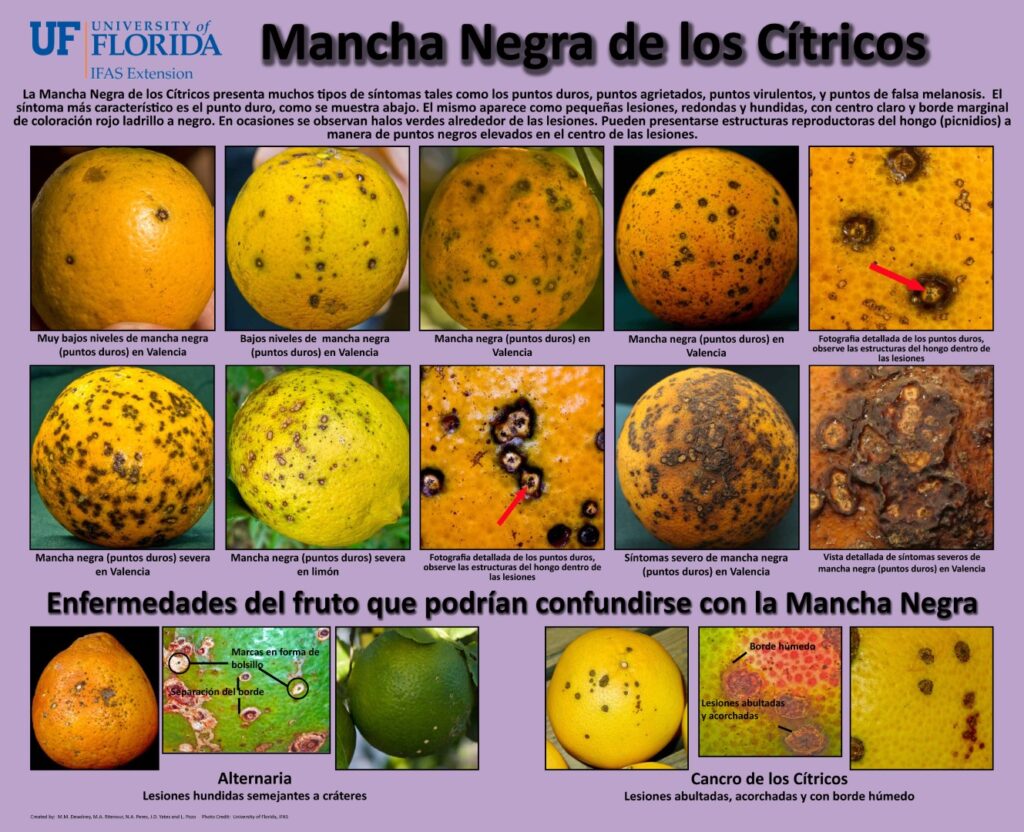- Intercitrus recalls that European regulations for this destructive citrus pest – which the EU describes as a “priority” because of its serious environmental and economic impact – require treatments in affected areas to be effective, but South Africa seems to be resorting to the cheapest ones.
- Before the decisive meeting of the SCoPAFF (Standing Committee on Plant Health of the EU) on the 21st and 22nd, it is calling for the imposition of automatic import closures if more than 5 interceptions per year of ‘Citrus Black Spot’ are exceeded and the imposition of cold treatment in transit to prevent T. leucotreta.
The Spanish Citrus Interprofessional considers, in the light of the repeated problems caused by the detection in European ports of ‘Citrus Black Spot’ in South African citrus consignments, that their producers/exporters are not complying with European legislation and are combating this fungus without using fungicides with proven efficacy in the field. They would do so purely as a matter of not incurring higher costs, even if it means exporting infected fruit to the EU. The public denunciation, previously reiterated in the relevant fora, comes just a day before tomorrow’s meeting of the EU Standing Committee on Plant Health (SCoPAFF), which is expected to last until Friday. On the agenda is the debate on measures to prevent the arrival of two foreign pests considered “priorities” by EU legislation due to their high environmental and economic impact: Phyllosticta citricarpa (known as ‘Black Spot’ or CBS, a dangerous fungus) and Thaumatotibia leucotreta (or False Moth, FCM, an insect). Intercitrus demands that the Spanish Government’s recent position, which calls for the application of cold treatment in transit to South Africa in order to avoid the FCM, be endorsed. In view of the successive non-compliances and the worrying figures for this year – and previous years – it is called for the establishment of an objective scale with regard to the ‘Citrus Black Spot’ which implies the automatic closure of South African imports in the event of exceeding five rejections for this reason over the course of a year.
South Africa will not only repeat in 2021 as the main non-European supplier of citrus to the EU – in the last 5 years it has exported between 650,000 and 840,000 tonnes – but now also as the origin that leads, by far and as has happened so many times before, the European port interceptions recorded up to September. It is the global leader in suffering the detection of quarantine organisms, but it is also the leader in particular for the two pests mentioned above: 42 rejections, 25 for ‘Citrus Black Spot’ and 15 for T. leucotreta. Moreover, the second country next in terms of CBS problems is Zimbabwe – with 7 rejections up to September, all recorded in that month – whose producers and main exporters are also South African.
The recent EFSA (European Food Safety Agency) report commissioned by the European Commission (EC) itself will be on the table of the officials of the SCoPAFF member states, which scientifically accredits that the ‘systems approach’ chosen by the southern country for its shipments of oranges, mandarins and lemons to Europe is far from complying with the Community regulations for the FCM, which requires guaranteeing the absence of this pest in its consignments. This fact, both for the Ministry of Agriculture and for Intercitrus, should be enough for Brussels to decide to impose the same cold treatment in transit that other citrus producing powers such as the USA, China, Japan, India, Korea and Australia apply to their imports to protect themselves against this pest. In addition, after successive warnings from the EC due to the problems historically accumulated by CBS and after verifying in Tunisia (where a major outbreak was declared in 2019) that this pathogen is perfectly acclimatised to the Mediterranean climate, the SCoPAFF will have to decide whether or not to tighten the conditions of its exports with regard to this fungus. Indeed, the EC ordered a ‘symbolic’ ban in November 2013 (as the campaign was already over) on imports for this reason, and South Africa, for its part and unilaterally, has been voluntarily and only partially interrupting its export campaigns to the EU in 2014, 2015, 2016, 2018 and 2020 in order to avoid further rejections and, above all, a firmer reaction from Brussels.
The evidence suggests that South Africa is indeed resorting to cheaper fungus treatments, which would not meet EU requirements to use the “most appropriate” fungicides in affected areas. To determine this, in 2014 EFSA collected quantitative estimates of the impact of ‘Citrus Black Spot’ in South Africa and the levels of disease control in its current area of distribution. The Expert Panel conducted a meta-analysis of disease incidence recorded in control (untreated) and treated plots and assessed the effectiveness of different groups of fungicides. The results showed that the treatments – 4-6 sprays per year are required for this fungus – were consistently able to reduce the proportion of diseased fruit. However, the effectiveness varied markedly between plots. In some plots – those treated with copper-based compounds – disease incidence was only slightly reduced, while the proportion of diseased fruit was reduced to zero in plots sprayed including, among others, the more expensive active substance strobilurins.

